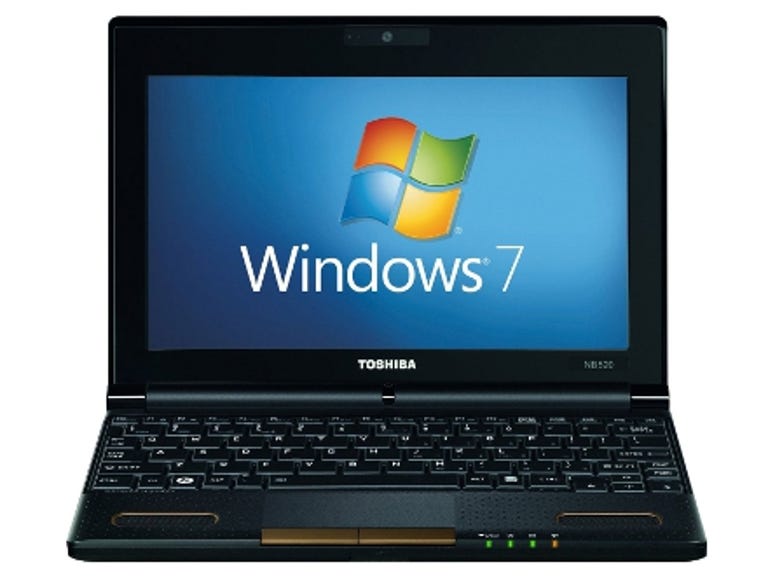 Why You Can Trust CNET
Why You Can Trust CNET Toshiba NB520 review: Toshiba NB520
The Toshiba NB520 netbook might lack the flashy design of some of its competitors, but decent performance, great speakers and impressive overall usability mean it's good value for money.
Most netbooks are so similar that, when something slightly different comes along, we get all giddy, like a teenager queuing for the Nemesis Inferno at Thorpe Park. The 10.1-inch Toshiba NB520 is just such a machine, sporting a dual-core Intel Atom processor, beefy Harmon Kardon speakers, a rubberised lid, and Bluetooth 3.0 support. But is this ride worth the £280 entry price? Buckle up and let's find out.
The Good
The Bad
The Bottom Line
Get your rubber on
The NB520's design is a mixed bag. It's available in five colours: brown, blue, green, orange and turquoise. These colours are used on the lid, which has a slightly rubberised coating. That coating means the lid should collect less scratches than the glossy version found on most netbooks. The lid also looks cool and feels pleasant to touch.
The matte black plastic used on the keyboard and wrist rest look cheap in comparison to the lid. Nevertheless, the machine feels quite sturdy, and the matte finish should stand up better than glossy coatings to long-term abuse.
Perhaps what most distinguishes the NB520 from its peers is the presence of two fairly large Harman Kardon speakers, housed behind metal grilles towards the front of the laptop. These help the machine to produce much louder and more convincing audio than any other netbook we've come across. In fact, they put the speakers on many larger laptops to shame. You can quite happily listen to music or enjoy movie soundtracks without having to reach for your headphones.
The 10.1-inch screen may be a pretty standard size for a netbook, but there's a pretty thick bezel around it that makes it look smaller than it really is. Also, while its 1,024x600-pixel resolution is adequate, the screen can feel cramped compared to netbooks with 1,366x768-pixel displays. On the plus side, we didn't find the glossy finish too reflective, and this coating makes colours look much richer than they do on matte displays.
The spacious keyboard is excellent. The trackpad's very smooth and accurate too.
Port ability
When it comes to ports, the NB520 doesn't stray too far from the well-trodden netbook path. There's the usual quota of three USB ports but, handily, one of these uses 'sleep and charge' technology, so you can charge devices like MP3 players and phones even when the netbook is powered down.
There's also an Ethernet port for connecting the netbook to a wired network and a VGA port for hooking the machine up to an external display. Toshiba hasn't managed to squeeze in an HDMI port, though. That's a shame, as such ports are starting to appear on rival models that fall into the same price bracket. Under the front lip, you'll find an SD card reader.

Along with Wi-Fi connectivity, Toshiba has added support for Bluetooth 3.0, which offers fast data transfer between compatible devices. There aren't a huge number of Bluetooth 3.0 devices around at the moment, but this is likely to change in the future, so it's something that's definitely worth having on your computer.
In common with all netbooks, there's no optical drive on the NB520, but the 250GB hard drive, which is divided equally into two partitions, will offer enough storage space for most users.
Core strength
To give this model extra oomph, Toshiba has opted for a dual-core Intel Atom N550 processor, clocked at 1.5GHz. The machine also has 1GB of RAM to play with.
The extra processor core didn't really make much difference in our benchmark tests -- the NB520 posted a score of 1,667 in PCMark05 -- but it does make the netbook feel slightly more responsive when it comes to day-to-day tasks. Predictably, the NB520's performance in the 3DMark06 graphics test was pretty dire, clocking up a rubbish score of just 146.
On the whole, the NB520 is fine for handling basic chores, like sending emails, browsing the Web and editing documents, but, despite its dual-core processor, it'll still struggle with anything more demanding.
Considering the dual-core processor is slightly more power-hungry than the single-core processor in most netbooks, it's a clever move on Toshiba's part to kit this model out with a larger ten-cell battery. The results are impressive. In the punishing Battery Eater Classic test, which runs the netbook's processor at full whack to simulate a constant and very heavy load, the NB520 managed to slug it out for 5 hours and 15 minutes. By way of comparison, the dual-core Samsung N350 lasted just 2 hours and 44 minutes in the same test.
Conclusion
There's not much to fault in the Toshiba NB520. It's one of the cheaper dual-core netbooks around, but offers good performance, a great keyboard and excellent speakers. The design may not be to everyone's taste, but we think this netbooks offers plenty of thrills for a pretty modest outlay.
Edited by Charles Kloet


